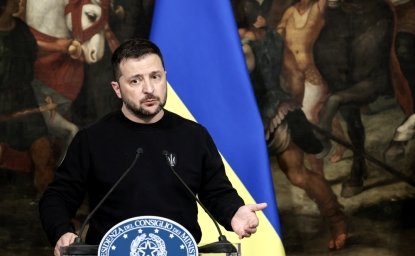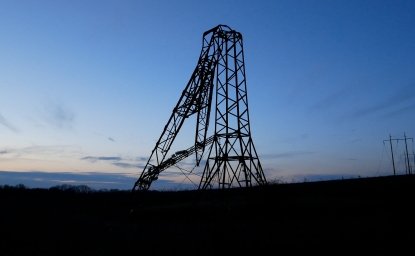
A blog of the Kennan Institute
BY ILIYA KUSA AND MIKHAIL MINAKOV
The Russian war on Ukraine has gone on for almost fifty days. And negotiations between Kyiv and Moscow—on two tracks so far—started the day after the Russian invasion. Even as the parties’ positions become clearer, no compromise seems to be on the horizon.
Two Tracks, and the People Involved
The first track of negotiations is being handled by two consulting teams. Several in-person meetings of the Ukrainian and Russian teams, led by David Arakhamia on the Ukrainian side and Vladimir Medinsky for the Russians, took place in Belarus during the early weeks of the war. Later, the teams working on this track began meeting more often to discuss enforcement of humanitarian corridors, POW exchanges, and, most important, the agenda for the meeting of the respective countries’ foreign affairs ministers.
The Ukrainian negotiating team includes representatives of President Zelensky’s team: David Arakhamia, leader of the parliamentary faction Servant of the People party (with which the president is affiliated); Justice Minister Denys Malyuska, adviser to the presidential office Mykhailo Podolyak, Defense Minister Oleksii Reznikov, Deputy Foreign Affairs Minister Mykola Tochitsky, and three MPs, Andriy Kostin, Dmytro Lubinets, and Rustem Umerov. In April 2022 the team was officially enlarged with the addition of two seasoned experts, the international lawyer Alexander Malinovsky and Alexander Chaly, Ukraine’s veteran diplomat. Most of the members of this group have direct access to President Zelensky and represent his administration.
The Russian delegation is headed by one of President Vladimir Putin's aides, Vladimir Medinsky, former minister of culture and chairman of the Russian Military Historical Society. The Russian delegation also includes Deputy Foreign Minister Andrei Rudenko, Russian ambassador to Belarus Boris Gryzlov, Leonid Slutsky, head of the State Duma International Committee, and Deputy Defense Minister Alexander Fomin. The members of Russian team have less access to President Putin and are a group of experienced bureaucrats trusted to implement the president’s wishes.
Another track of negotiations is ongoing at the foreign affairs ministerial level. Ukrainian foreign affairs minister Dmytro Kuleba and his Russian counterpart, Sergei Lavrov, have met twice, in Antalya, Turkey, on March 10 and again in Istanbul on March 28. Talks on this track have led to highly important decisions, such as the withdrawal of Russian troops from three northern Ukrainian oblasts, and to the preparation of some sort of deal that might be agreed to at a future possible meeting of Presidents Zelensky and Putin. (This meeting is not yet in the works). However, this track appears to have reached a stalemate. On April 7, Lavrov issued a public statement claiming that Ukraine had presented him with a draft peace agreement that “deviated” from proposals both sides had previously agreed on “in writing.”
The MFA track has involved mediation by the Israeli and Turkish leadership and some other negotiators, including unofficial ones such as Roman Abramovich. Also, many other powers from the West and East participate in this track.
Political issues related to resolving the principal disagreements between Russia and Ukraine in the longer-term perspective—including the status of the occupied territories, security guarantees for Ukraine, Ukraine’s neutrality and non-nuclear status, and so forth—moved to the forefront of negotiations almost immediately, in parallel with discussions more directly related to the conflict itself, such as a permanent ceasefire, POW exchanges, evacuation efforts, and access by humanitarian aid organizations.
Positions of the Parties
The positions of the parties—Ukraine and Russia, as well as the United States, the UK, the EU, and the Asian powers—can be sketched briefly in the following way.
Ukraine insists on a return to the prewar status quo, meaning that Russian troops are to withdraw at least to the positions held before February 24. President Zelensky and his aides have constantly emphasized that Russia should contribute financially to Ukraine’s postwar reconstruction efforts and pay compensation to all war victims. Should Moscow refuse, sanctions are to be preserved even after a formal ceasefire agreement has been concluded. In addition, the Ukrainian authorities want the territories occupied in 2014 to remain subject to further negotiations. In the interim, Ukraine insists on the need for Moscow to withdraw its recognition of the self-proclaimed republics in the Donbas. It seems that Kyiv is ready to make concessions on its NATO membership aspirations and is ready to talk about neutrality under strong foreign guarantees, including Russia’s.
The Russian position has evolved over the last fifty days. In the first weeks of the war Moscow’s political demands included not only that Ukraine not join NATO or that Ukraine change its constitution to remain neutral, but also certain restrictions on the size of Ukraine’s defense system, the number of military personnel, and the volume and types of arms imports. Culturally, Moscow demanded that Ukraine constitutionally include the Russian language as the second official language and ban far-right organizations. Finally, Moscow insisted on Ukraine’s recognition of occupied Crimea as part of Russia and the so-called Donbas people’s republics as independent states.
Currently, it seems that the Russian demands have been scaled down, especially after it became clear that Moscow couldn’t take Kyiv and control Ukraine’s northern regions. In recent weeks Moscow has shifted its military focus to eastern and southern Ukraine, where Russian ground forces have managed to make some progress. Russia’s recent demands are mainly focused on Ukraine’s neutral and non-nuclear status, dropping the NATO membership topic and nondeployment of foreign military bases or weapon systems. Moreover, while it seems that Russia is willing to withdraw from the territories occupied after February 24, it is unlikely to leave Ukraine’s southern and eastern regions, where Russia has significant manpower deployed and has already started recruiting local politicians to establish new occupational authorities.
Today, for Russia, it seems imperative to have at least a minimum “victory kit” comprising the following: (1) control of the city of Mariupol, (2) expansion of the self-styled Donbas people’s republics to the limits of their oblast administrative borders, (3) a permanent military presence in Kherson oblast sufficient to guarantee freshwater supplies to Crimea, and (4) preservation of the land bridge connecting the separatist-controlled territory in the Donbas with the occupied Crimean Peninsula by way of the Sea of Azov coast and Kherson oblast. This would be enough for the Russian government to declare victory.
The United States and the UK seem to by expecting a long-term proxy war against Russia through Ukraine. Such an extended engagement would allow retention of the anti-Russian sanctions, a further consolidation of Western allies, and a weakening of Russia in the long term. These are some of the reasons why American and British officials were initially skeptical or guarded with respect to Ukraine-Russia peace talks. For Washington and London, a quick peace settlement, however short-lived, would allow Russia to bounce back from its military venture and regroup, while some European partners would ease up on the sanctions regime and restore at least some trade ties with Moscow.
The European countries are clearly divided on the Russia-Ukraine war issue. While the EU member states seem to be consolidated on the need to respond to the Russian military invasion, they have their differences when it comes to burning bridges with Moscow, strengthening the sanctions pressure, or giving Ukraine more sophisticated weaponry. Germany, the Netherlands, Austria, France, Belgium, and other Western European countries want this war to end as soon as possible. A quick end would allow them to stabilize markets and commodity prices, make the threats to socioeconomic stability manageable, and partially restore trade with Russia. On the other hand, Poland, Slovenia, Lithuania, Latvia, and Estonia are pushing for more sanctions against Russia, including a total energy embargo and a transport blockade, and for the delivery of more sophisticated weaponry to Ukraine, including planes, tanks, and anti-aircraft systems.
Most countries in the global south, including such heavyweights as India, Pakistan, China, Indonesia, Malaysia, Uzbekistan, the UAE, Saudi Arabia, and Egypt, continue to insist on enhancing the West-Russia dialogue and achieving peace in Ukraine as soon as possible. However, several countries are also eyeing a potential role as a future guarantor of Ukraine’s security, with China, Turkey, and Israel among them.
In a long-term perspective, Asian and African countries believe that the war in Ukraine should lead to the establishment of a new post-Cold War security architecture, one not dominated by Western institutions. For them, Russia seems to be a challenger to the West and a champion of such a geopolitical shift.
In this intersection of competing interests, it is too early to come up with a clear vision of what the framework for a possible peace deal might look like. It seems clear that the bulk of the negotiations will be dedicated to determining the lines along which the parties will have staked out their positions by the time a ceasefire agreement is reached. Territorial control will determine not only the future military and political balance between Russia and Ukraine but also the prospects for Ukraine to successfully recover economically.
Moreover, the status of Crimea and the Donbas is a key issue on the negotiators’ agenda, owing to the enormous significance of the issue for the highly polarized domestic audiences of both Ukraine and Russia. Finally, the modality of Ukraine’s neutral status will be of high interest to Moscow and Kyiv. Ukraine clearly wants to minimize any limitations on its sovereignty inscribed in any possible neutrality agreement, while Russia is expected to try to impose additional arms restrictions and weaken foreign security guarantees for Ukraine.
Still, it is too early to know what framework might emerge, especially as the war is continuing. The battle for Ukraine’s East is likely to be crucial to the overall outcome of the war and the parties’ negotiating positions. Meanwhile, atrocities and war crimes continue to take place in Ukraine.
The opinions expressed in this article are those solely of the authors and do not reflect the views of the Kennan Institute.
Authors



Kennan Institute
The Kennan Institute is the premier US center for advanced research on Eurasia and the oldest and largest regional program at the Woodrow Wilson International Center for Scholars. The Kennan Institute is committed to improving American understanding of Russia, Ukraine, Central Asia, the South Caucasus, and the surrounding region though research and exchange. Read more

Explore More in Focus Ukraine
Browse Focus Ukraine
Building a Thriving Ukrainian Design Community Now

Ukraine Seeks to End the War. What's Wrong With the “Peace Scenarios”?


